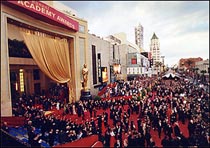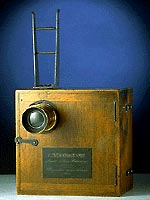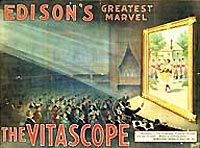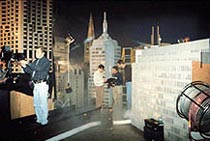| (insert your NIE or newspaper logo here) |
Weekly Online LessonOnline Lesson ArchiveGrade Level: 6-12
|
Cinema's Effects
 Anxious movie stars looking their best lit up the red carpets and television screens on Sunday, February 29, 2004, to find out who was taking home an Oscar, and who was not.
Anxious movie stars looking their best lit up the red carpets and television screens on Sunday, February 29, 2004, to find out who was taking home an Oscar, and who was not.
The 76th annual Academy Awards, hosted by the Academy of Motion Picture Arts and Sciences, not only honors actors, however. They also honor those films with the best special effects, used to visually enhance movies like The Lord of the Rings: The Return of the King, Master and Commander: The Far Side of the World, and Pirates of the Caribbean: The Curse of the Black Pearl.
These effects, when done well, make the improbable believable, further drawing viewers into a film's illusion. While movie-goers typically enjoy films as art and entertainment, behind the scenes, science and technology play an equally important role in these illusions.
So to get a better appreciation of the nature of film and the evolution of cinema and special effects, you'll start this week's lesson shedding light on how cameras and television screens work. Then you'll zoom in on special effects to find out how they're done and how they've improved over the years.
Your Insight To Cinema
 Without film and cameras, there would be no visual effects as we know them today. And, without television cameras and screens, no one would have been sitting at home watching the Oscars.
Without film and cameras, there would be no visual effects as we know them today. And, without television cameras and screens, no one would have been sitting at home watching the Oscars.
So to begin, let's head over to the American Museum of the Moving Image, and go into their Online Exhibitions gallery with your Flash player. Here, scroll down the exhibit list and choose Shutters, Sprockets and Tubes. This opens a pop-up window. Click Begin program.
Begin on the left-side, and click on The Illusion of Motion box. After it's loaded, follow the instructions.
 How exactly does the combination of the frame rate and shutter speed trick our eyes into seeing continuous motion?
How exactly does the combination of the frame rate and shutter speed trick our eyes into seeing continuous motion?
At the main menu, choose the next section in sequence, How Film Cameras Work. -- after all, you can't view a film if it hasn't been created!
In what ways are the process of capturing and the process displaying of film images related? How is a film camera similar to how our eyes work? Why does digital recording allow more creative editing compared to film?
Now see how Television Cameras Work. What is the fundamental difference between film and television cameras in how they capture and transform images? Why does light combine color in an additive fashion? What is it about the charge coupling device that revolutionized the visual effects industry?
But a movie wouldn't be nearly as interesting if it didn't also include sounds of conversation and action. So next, see what's involved in Recording Sound.
 How exactly do the electrical waves travel across space, get transformed along the way, and yet playback a duplicate of the original sound for us to hear? What's the importance of an amplifier? Do well do the analog and digital waves match? How might this affect the quality of the duplicate sound compared to the original?
How exactly do the electrical waves travel across space, get transformed along the way, and yet playback a duplicate of the original sound for us to hear? What's the importance of an amplifier? Do well do the analog and digital waves match? How might this affect the quality of the duplicate sound compared to the original?
Now that you've seen how the sound and film get put together, let's take a tour of How Film Projectors Work. How has digital technology changed the way movies are projected?
Finally, let's move from the big screen and return home to the little screen, where many of us will watch not only the annual Oscars but video tapes and DVDs throughout the year. So go see How Televisions Work. How is television technology different from the way film projectors work? Do they share any similarities? Why has digital technology changed the quality of movies we view at home?
Special Effectiveness
 So now that you know the basics of film making and projecting, let's check out how special effects are created and added to a movie at NOVA's Special Effects: Titanic and Beyond site.
So now that you know the basics of film making and projecting, let's check out how special effects are created and added to a movie at NOVA's Special Effects: Titanic and Beyond site.
To get a rough idea of how one of these visual illusions is created, play Attack of the 50-Foot Chicken, either through the Shockwave or non-Shockwave version. What's the importance of the countermatte?
Also take the challenge of the Titanic: What's Real game. Make some guesses before clicking -- which ones did you guess correctly? Can you think of any other movies that may have used miniature models like Titanic?
Next, see how special effects have evolved along with film technology and creativity by browsing the Reel Timeline: 1890 - Future.
 Begin in the 1890s, and continue through the timeline into the 1900s, 1910s, 1920s, 1930s, 1940s, 1950s, 1960s, 1970s, 1980s, and 1990s.
Begin in the 1890s, and continue through the timeline into the 1900s, 1910s, 1920s, 1930s, 1940s, 1950s, 1960s, 1970s, 1980s, and 1990s.
What's stop-motion animation, and how does it relate to the nature of filmmaking? What was the first movie to use electronic motion control? During which decade did computer graphics begin appearing on the silver screen? How did these technological changes shape the nature of movies?
So who controls these illusions? Make a stop at the So You Want To Be In Pixels section to meet a couple of these special effects experts, Glenn McQueen and Ellen Poon. What resources -- technology-based and from real life -- do Glenn and Ellen draw upon to create and animate characters?
Lastly, take a look into the challenges of making better Virtual Humans. What are some reasons that special effects artists and engineers want to develop virtual humans? What are some of the positive and negative aspects of doing so?
Newspaper Activities
Look through a current issue of Targetnewspaper to dig into the details of Oscar night. Who won in the Visual Effects category? What were some of the specific scenes or sequences that helped the film win that award? Where any particularly creatively unique or technologically new? Did any of the nominated films use miniatures? In what ways did each use computer generated graphics or animation? How did nominees do in the Sound Editing and Sound Mixing categories?
© Copyright 2004
Learners
Online,
Inc.
